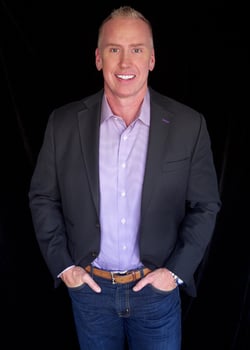Today we’re sharing insight from guest blogger Michael Erath, Certified EOS® Implementer and best-selling author. We hope you enjoy Michael’s wisdom and perspective.
 One of the most common frustrations I hear from the entrepreneurs and business leaders I talk to and work with is that they keep struggling with the same issues over and over. No matter how much time they spend talking about and meeting to solve their issues, the same ones just keep coming back up.
One of the most common frustrations I hear from the entrepreneurs and business leaders I talk to and work with is that they keep struggling with the same issues over and over. No matter how much time they spend talking about and meeting to solve their issues, the same ones just keep coming back up.
At its core, I believe the problem lies in something that many of us find incredibly difficult: openly and honestly addressing the true root causes of the issues. When we fail to hit the nerve when addressing issues, we find ourselves stuck talking about symptoms of deeper issues, and we rarely, if ever, solve our issues at the root. Failure to “kill it at the root” means it will keep coming back.
That leads me to the title of this blog. Some of you may recognize it as the first part of Proverbs 27:6, which says, “Faithful are the wounds of a friend; profuse are the kisses of an enemy.”
Let’s look first to the latter and put this in the context of a team. If somebody is giving undue praise, or avoiding bringing up something that is holding the team back because they don’t want to upset anybody, they are acting as an enemy to the team. Their unwillingness to get their thoughts or concerns out of their head is actually holding the team back and hurting the overall team’s health. In their mind, many people often justify this as being nice or not wanting to upset anybody.
Now to the statement, “Faithful are the wounds of a friend.” When we really care about something or someone, we must be willing to be completely open and honest about the root causes of our issues, even if it may be difficult for someone on the team to hear. When we do, we are acting as a friend to the team. We are actually saying that we care enough about the person and the team to accept the temporary punishment or discomfort that may come back on us for being open and honest with them. Of course, there are productive ways to do this, but to really get to a high level of team health and successful issues solving, team members must be willing to accept that sometimes there will be short-term discomfort when they are open and honest. Ultimately, it is all about doing what is best for the greater good of the team.
So think about that the next time you are preparing for a meeting. Can you create an open and honest issues list? Can you get the issues out of your head and written down on a piece of paper to take into the meeting? As a team, can you create an issues list on a flip chart or white board during your meetings so that all of the issues are out of your heads and on display for everybody to see? There is great therapy in just getting them out of your head.
Three Steps To Better Issues Solving
As a Certified EOS® Implementer, the process I teach teams for solving issues efficiently and permanently can be summarized by with three letters: I-D-S. The letters stand for the three steps of the process: Identify, Discuss, and Solve.
- Identify: Start with your issues list on display, and ask the team to quickly state the three biggest issues on the list. (In the event that you run out of time, you always want to solve the biggest issues first.) Once the top three are identified, just start with number one. The first step is for the person who brought that issue to the list to restate it in the shortest sentence possible, really trying to hit the nerve of the issue. When that is done, go around the group and be sure that everybody agrees the stated issue is really getting to the root and that there is nothing deeper. Doing this well will help you dig down to root causes and stop just putting bandages on symptoms.
- Discuss: This is the step where each person gets to say their peace or state their opinions about the issue—but only once—because more than once and you’re “politicking.” It is in these endless political debates about issues where most teams get stuck wasting countless hours accomplishing nothing. Strive to get in and out of this step efficiently, and don’t go back.
- Solve: If you really got to the root cause in step one, and if everybody said what really needed to be said in step two, then the solutions often become obvious and are almost always already in the room. During this step, it is critical that you stay focused on solutions and don’t drift back into “discuss.” Ask yourselves what action items can be carried out in the next one to two weeks that can bring about a solution to the issue. As you create this list of action items, put them on a “To-Do" list. Be sure that somebody on the team owns each To-Do, and follow up in the next week’s meeting to be sure the To-Do's are getting “To-Done".
Confronting the root issues like this takes courage and it takes being a true friend to the team and to the greater good of the organization. Creating a strong issues list is the first step to solving issues so that they go away forever. Mastering this process takes time and practice, but if you stay focused on following this simple three-step process to issues solving, you will begin to find that you are able to solve issues in a way that makes them go away forever.
What’s The Risk?
If nothing changes, nothing changes. If you and your team struggle to get to the root cause of your issues and instead just talk them to death – never really identifying the real issue and never really solving it for good – then you are destined to remain exactly where you are. You can continue to avoid being direct and hitting the nerve when identifying the issue, and you can continue dealing with the same frustrating issues over, and over, and over again. As Mark Twain said, “If you always do what you’ve always done, you’ll always get what you’ve always got.”
Next Steps
Take a short test to see how your organization is doing. Click here to take a brief organizational check-up that will tell you how you’re doing in the Six Key Components™ of the EOS® Model.
Download a free chapter of Michael’s Amazon Best-Selling book RISE: The Reincarnation of an Entrepreneur here.
This content was written and shared by Michael Erath.
 Having grown up in a family manufacturing business which he grew from $8 to $18MM in 10 years as CEO, Michael has spent his entire career in the trenches of the entrepreneurial world. He also co-founded a Hardwood Timber Trading Company in 1999 which grew from start-up to a $27MM business in 2007. Since 2003 he has been an active member of several business peer groups – YPO, where he spent 9 years in Forum as a member of the Southern 7 Chapter; EO, where he continues his Forum experience as a member of the Arizona Chapter; and Vistage, where he was a member of a Trusted Advisors Group in Columbus, Ohio.
Having grown up in a family manufacturing business which he grew from $8 to $18MM in 10 years as CEO, Michael has spent his entire career in the trenches of the entrepreneurial world. He also co-founded a Hardwood Timber Trading Company in 1999 which grew from start-up to a $27MM business in 2007. Since 2003 he has been an active member of several business peer groups – YPO, where he spent 9 years in Forum as a member of the Southern 7 Chapter; EO, where he continues his Forum experience as a member of the Arizona Chapter; and Vistage, where he was a member of a Trusted Advisors Group in Columbus, Ohio.
When the housing market crashed in 2009, Michael lost everything. Due to a combination of declining sales, betrayals from key staff, and personal shortcomings, Michael went from owning two multi-million dollar businesses to almost destroying his marriage, losing his home and companies, and struggling to make ends meet. But he didn’t let failure keep him down. Instead, he learned from his mistakes and rose back to success.
In 2010, Michael leveraged everything he had and started a new manufacturing business, which he continues to own to this day. In early 2014, an EO colleague introduced Michael to the Entrepreneurial Operating System (EOS®) by way of the book TRACTION. In EOS®, for the first time in his 20-year career, Michael found a simplified, holistic system that created a perfect framework with which to operate his business.
Since implementing EOS® in his own business, Michael now has a strong and unified Leadership Team who manages the day-to-day operations of the business, which has freed him from the overwhelming control the business had been having over his life. With that newfound freedom, Michael has been able to pursue his greatest passion, which is to work with fellow entrepreneurs as a Certified EOS Implementer to help them strengthen their businesses by implementing the Entrepreneurial Operating System. To do so, he founded SMART Direction in 2015 and now works full-time with leadership teams of entrepreneurial companies from SMART Direction's Phoenix based “Dojo”.
Michael's journey inspired him to help others avoid the mistakes he made by writing his first book, RISE: The Reincarnation of an Entrepreneur. In RISE, Michael recounts his remarkable story with brutal honesty and self-reflection. He demonstrates how systemizing a business and building healthy, open, and honest leadership teams can help business leaders free themselves from the control their business has over them and find time to pursue other passions. He calls it Entrepreneurial Freedom – Getting out of your own way and living your ideal life with a business that you own, rather than a business that owns you.
Michael lives in Phoenix with his wife Elizabeth and their French Bulldog, Rocco. They have two adult sons.
Connect with Michael on LinkedIn, Facebook, Twitter, and via the SMART Direction website.




